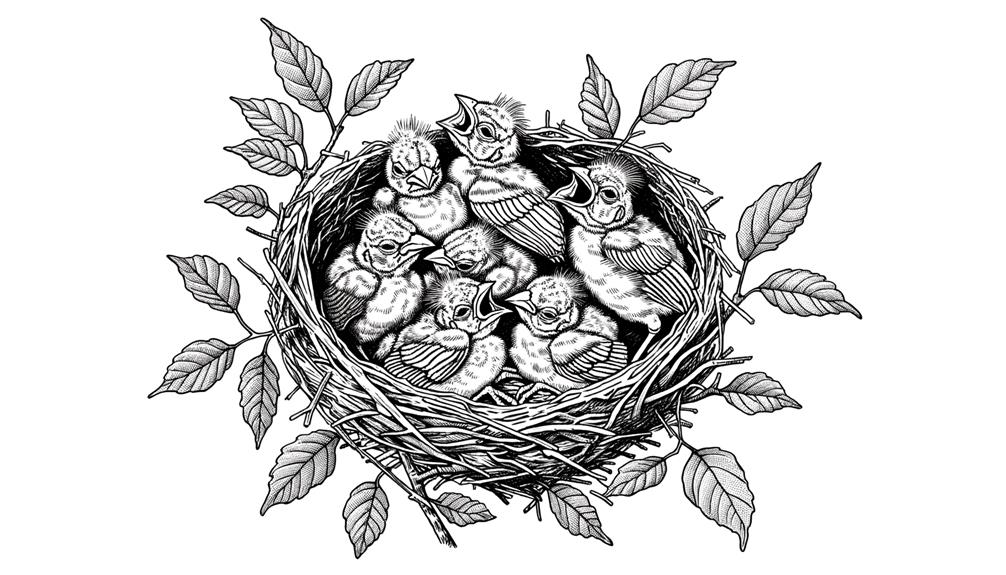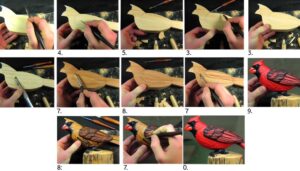How Many Babies Do Northern Cardinals Have at One Time?
Northern Cardinals typically lay 2 to 5 eggs per clutch. Nest construction spans 3-9 days, with females laying eggs that measure approximately 2.3 cm in length.
Incubation takes 11-13 days, during which the female turns and maintains the eggs' temperature. Both parents support feeding and protecting the nestlings, which fledge at 9-11 days old.
Northern Cardinals often produce multiple broods each season, generally consisting of 3-4 eggs. The variability in clutch size allows for adaptation to environmental conditions, such as food availability and predation risk, influencing reproductive success.
To learn more about their intriguing reproductive behaviors please continue.

Key Takeaways
- Northern Cardinals lay between 2 to 5 eggs per clutch.
- Each brood typically consists of 3-4 eggs.
- Females may have multiple broods per season, each with 2-5 eggs.
- Clutch size is influenced by food availability and habitat quality.
- Older females tend to have larger broods compared to younger ones.
Northern Cardinal Nesting Sites

Northern Cardinals typically choose nesting sites that are well-hidden within thick shrubs or low tree branches, often positioned between 1 to 15 feet above the ground. They display a preference for locations that offer ample foliage cover, providing both concealment from predators and shelter from the elements.
Preferred shrubs often include honeysuckle, multiflora rose, and dogwood. The selected sites frequently have an average height of around 6 feet, optimizing both access and security. Cardinals choose sites with a dense, tangled branch structure, creating a microhabitat that minimizes exposure.
These strategic choices guarantee a higher survival rate for their offspring. By carefully selecting these nesting sites, Northern Cardinals improve their reproductive success and safeguard the well-being of their young.
Nest Construction Process
Once a suitable nesting site is selected, the female begins the intricate process of constructing the nest, which typically takes three to nine days. She meticulously gathers twigs, leaves, and bark, creating an outer framework approximately 10-12 centimeters in diameter.
Using finer materials such as grass and rootlets, she weaves a dense inner lining, ensuring insulation and comfort. During construction, the female shapes the cup by pressing her body against the interior, achieving a depth of around 5-7 centimeters.
Observations indicate that the nest is usually situated in dense shrubs or low trees, approximately 1 to 3 meters above ground. This strategic placement offers protection from predators and environmental elements, optimizing conditions for the forthcoming eggs and hatchlings.
Egg Laying Pattern

The egg-laying pattern of Northern Cardinals exhibits significant clutch size variability, typically ranging from 2 to 5 eggs per nest. They often engage in multiple nesting attempts per breeding season.
With an average incubation duration of 11 to 13 days, this cycle guarantees a high frequency of reproduction, maximizing their reproductive success.
Clutch Size Variability
Cardinal clutch size exhibits significant variability, typically ranging from two to five eggs per breeding attempt. This variation depends on several factors, including environmental conditions, food availability, and parental health.
The eggs, which measure approximately 2.3 cm in length, are laid at daily intervals. Observational studies indicate that ideal clutch sizes often correlate with abundant resources, ensuring higher survival rates.
Additionally, the female's age and experience play vital roles; older, more experienced females tend to produce larger clutches. Importantly, researchers have documented that clutches of three or four eggs are most common, offering a balance between resource allocation and offspring survival.
Understanding these dynamics provides insights into the reproductive strategies of Northern Cardinals.
Nesting Frequency
Typically, Northern Cardinals exhibit a breeding pattern where they lay eggs two to four times per season, with each nesting cycle separated by roughly four to five weeks. This frequency allows them to maximize reproductive success within a given breeding season.
Observations indicate that cardinals commence nesting as early as March and can continue until late August. The females lay between three to four eggs per clutch, and the interval between clutches guarantees sufficient time for nest construction and care for the fledglings.
Environmental factors such as temperature, food availability, and habitat quality can influence the exact timing and frequency of nesting. Monitoring these patterns provides critical data for understanding their reproductive strategies and population dynamics.
Incubation Duration
Following nest construction, female Northern Cardinals begin the incubation process for their eggs, which typically lasts between 11 to 13 days. This precise duration ensures optimal development of the embryos.
Observations indicate a consistent egg-laying pattern, with females generally laying one egg per day. The number of eggs in a clutch usually ranges from three to four, though occasionally, five eggs are observed.
During this period, females maintain a stable temperature and humidity level within the nest.
Key points of the incubation process include:
- Incubation Duration: 11-13 days.
- Egg-Laying Frequency: One egg per day.
- Clutch Size: Typically 3-4 eggs.
- Nest Conditions: Controlled temperature and humidity.
This meticulous care is vital for the successful hatching of Northern Cardinal chicks.
Number of Eggs
A female Northern Cardinal generally lays between two to five eggs per clutch. These eggs exhibit a range of coloration from white to pale greenish, often speckled with brown or gray markings. Each egg measures approximately 2.3 cm in length and 1.7 cm in width, showcasing a slightly elliptical shape.
The variation in clutch size may depend on environmental factors, food availability, and the age of the female. During the breeding season, Northern Cardinals may produce multiple clutches, thereby increasing their reproductive success. These observations highlight the species' adaptability and resilience in various habitats.
Understanding the number of eggs laid provides critical insight into the reproductive strategies and population dynamics of Northern Cardinals.
Incubation Period

Once the female Northern Cardinal lays her eggs, she begins the incubation period, which typically lasts between 11 to 13 days. During this time, she maintains a constant temperature to support proper embryonic development.
This period is marked by several critical behaviors and conditions:
- Temperature Regulation: The female carefully regulates the nest's temperature, usually keeping it between 98°F and 100°F.
- Nest Attentiveness: She remains on the nest for approximately 80% of the day, leaving only briefly to feed.
- Egg Turning: The female turns the eggs multiple times daily to prevent the developing embryos from sticking to the shell.
- Environmental Monitoring: She stays alert to potential threats, ready to defend the nest from predators.
These careful efforts support ideal conditions for the developing chicks.
Hatching Timeframe
The hatching timeframe for Northern Cardinals spans approximately 11 to 13 days during the egg incubation period.
Observations indicate that nestling development stages commence immediately post-hatching, with rapid growth and feather development noted within the first week.
Precise measurements show that nestlings fledge around 9 to 11 days after hatching, marking a critical phase in their early life cycle.
Egg Incubation Period
Typically, Northern Cardinal eggs incubate for about 11 to 13 days before hatching. This period is essential for embryonic development, requiring optimum temperature and humidity levels. Observations indicate that the female cardinal primarily undertakes incubation duties, maintaining consistent warmth. The male assists by providing food to the female during this time.
Key factors influencing successful incubation include:
- Temperature Regulation: The female maintains an average nest temperature of approximately 37.5°C.
- Humidity Control: Adequate humidity prevents egg desiccation, necessary for proper embryonic development.
- Nest Protection: Both parents actively guard the nest against potential predators.
- Parental Feeding: The male's role in feeding the incubating female ensures she remains nourished and attentive.
Understanding these factors is crucial for comprehending the incubation process of Northern Cardinals.
Nestling Development Stages
Nestlings emerge from their eggs typically 11 to 13 days after incubation begins, entering a critical stage of growth and development. Initially, they exhibit altricial characteristics, meaning they're born blind, featherless, and entirely dependent on parental care.
During the first week, rapid physiological changes occur; their eyes open by day four to five, and pin feathers start appearing. By day seven, these structures develop into recognizable feather tracts. The parents feed the nestlings a diet rich in protein, primarily insects, to sustain this accelerated growth.
Chick Development Stages

Observing chick development stages, one notes that Northern Cardinal chicks hatch blind and nearly featherless, relying heavily on parental care. Over the first few weeks, these chicks undergo significant changes, marked by distinct stages.
- Day 1-3: Chicks are altricial, with closed eyes and minimal movement.
- Day 4-6: Eyes begin to open slightly, and pinfeathers emerge.
- Day 7-10: Feather development accelerates; chicks start to exhibit more mobility within the nest.
- Day 11-13: Feathering completes, and chicks prepare for fledging.
Feeding the Chicks
Parental cardinals diligently provide a diet rich in protein and fats, primarily consisting of insects and seeds, to promote peak growth and development of their chicks. They engage in frequent feeding sessions, ensuring each chick receives adequate nourishment. Observations indicate that chicks are fed approximately every 10 minutes during daylight hours.
| Food Type | Nutrient Content | Feeding Frequency |
|---|---|---|
| Insects | High protein | Every 10 minutes |
| Seeds | High fats | Every 20 minutes |
| Berries | Vitamins | Every 30 minutes |
The parents select food items based on their nutritional value, often opting for caterpillars and grasshoppers for their substantial protein content. This meticulous feeding schedule is essential for the rapid growth and energy demands of the developing chicks.
Parental Roles

Both male and female Northern Cardinals frequently share responsibilities in nurturing and protecting their offspring. Their cooperative behavior enhances the survival and growth of their young. Specifically, their roles include:
- Nest Construction: Males collect materials, while females build the nest, ensuring structural stability.
- Incubation: Females primarily incubate the eggs, maintaining an ideal temperature of approximately 37°C over 11-13 days.
- Feeding: Both parents feed the nestlings, delivering a diet rich in insects and seeds to support rapid development.
- Protection: Males vigilantly guard the nest, deterring predators and alerting the female to potential threats.
This division of labor maximizes efficiency and increases the likelihood of chick survival, exemplifying the Northern Cardinals' effective parental strategies.
Fledging Process
As the nestlings grow stronger, they reach the fledging stage at approximately 9 to 11 days old, marking a pivotal phase in their development where they leave the nest and begin learning to fly and forage.
During this period, the young cardinals exhibit increased wing flapping and short flights. Parental supervision is essential; adult cardinals remain nearby, providing food and protection.
Observations indicate that fledglings often hide in dense vegetation for safety. Their initial flight capabilities are limited, and they depend heavily on their parents for sustenance and guidance.
Gradually, over the next few weeks, fledglings improve their flying and foraging skills, ultimately achieving greater independence. This stage is crucial for survival and future reproductive success.
Multiple Broods Per Season

Curiously, Northern Cardinals often have multiple broods per breeding season, typically producing two to three sets of offspring annually. This reproductive strategy enhances their survival rate and genetic diversity. Each brood consists of three to four eggs, with both parents actively participating in feeding and protecting the young.
Here are the stages of multiple broods:
- First Brood: Typically laid in early spring, around March or April.
- Second Brood: Laid in late spring or early summer, around May or June.
- Third Brood: If conditions are favorable, a third brood may be laid in July or August.
- Parental Duties: Both parents feed the fledglings for up to two weeks post-fledging before preparing for the next brood.
This cyclical pattern secures the propagation of the species.
Factors Affecting Brood Size
Brood size in Northern Cardinals is influenced by several key factors including the female's age and experience, which directly impacts reproductive success. Availability of food resources, quantified by the density of insect prey and seed production, also plays a critical role.
Additionally, environmental conditions such as temperature and precipitation patterns notably affect the viability of the offspring.
Female's Age and Experience
Studies indicate that a female Northern Cardinal's age and experience influence the size of her brood. Older and more experienced females tend to have larger broods compared to younger, less experienced counterparts. This correlation is supported by several detailed observations:
- Age: Females in their prime reproductive age produce more eggs, averaging 3-4 per clutch.
- Experience: Experienced females exhibit better nesting site selection, enhancing survival rates.
- Brood Care: Experienced females display superior brood care techniques, resulting in higher fledgling success.
- Efficiency: Older females optimize energy usage during incubation, ensuring better egg viability.
These factors combined suggest that maturity and learned behaviors boost brood size and overall reproductive success in Northern Cardinals.
Availability of Food
The availability of food directly influences the brood size of Northern Cardinals, with abundant food resources leading to larger clutches. Studies indicate that when food supply is ample, Northern Cardinals typically lay between three to four eggs per clutch.
In contrast, limited food availability often results in reduced clutch sizes, sometimes as few as one to two eggs. Food resources such as seeds, fruits, and insects provide essential nutrients, impacting the female's reproductive capacity.
Detailed observations reveal that during periods of high food abundance, nestling survival rates also increase, enabling larger brood sizes to be maintained. Precise measurements demonstrate that areas rich in food sources significantly contribute to the reproductive success and overall population stability of Northern Cardinals.
Environmental Conditions
Environmental conditions, such as temperature, humidity, and predation risk, have a significant impact on the brood size of Northern Cardinals, often interacting with food availability to determine reproductive outcomes. Detailed observations reveal that favorable conditions enhance reproductive success, while unfavorable conditions can limit brood size.
Key factors include:
- Temperature: Ideal temperatures (20-25°C) promote higher brood sizes, while extremes (below 10°C or above 30°C) reduce egg viability.
- Humidity: Moderate humidity (40-60%) supports nestling development; excessive humidity (>80%) increases fungal infections.
- Predation Risk: High predation areas correlate with smaller broods due to increased nest disturbance.
- Food Availability: Abundant food sources amplify brood size, compensating for minor environmental stressors.
Understanding these factors provides insights into the reproductive strategies of Northern Cardinals.
Conclusion
To sum up, northern cardinals commonly clutch three to four eggs per nesting, showcasing a consistent egg-laying pattern. This meticulous process, marked by careful construction and calculated incubation, culminates in coordinated parental care.
Fledging follows a fixed timeframe, fostering fledglings' flight. Multiple broods per breeding season are frequent, influenced by environmental elements and food availability. These factors collectively contribute to the cardinal's reproductive success, highlighting nature's nuanced, nurturing, and resilient reproductive rhythms.






